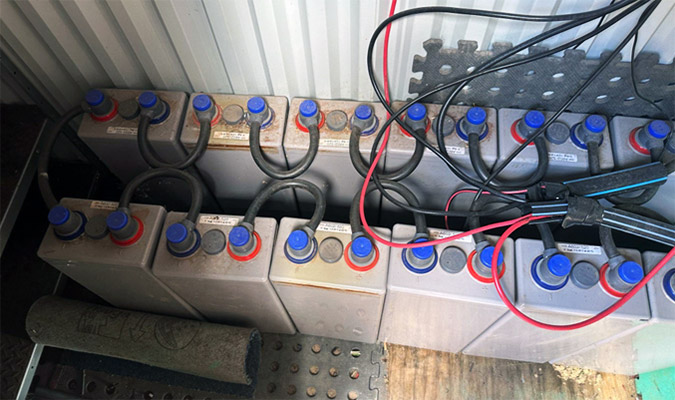Lead-acid battery is the most widely used rechargeable battery. They are reliable, low cost, and able to provide high surge currents. They work based on a reversible electrochemical reaction between lead and lead dioxide with a sulfuric acid electrolyte.
The use of lead-acid batteries in the solar industry is primarily for energy storage in off-grid and hybrid solar systems. These batteries store excess energy generated by solar panels during periods of sunlight for later use when the panels aren’t producing electricity (during the night or on cloudy days). They help provide a continuous and reliable power supply.
How Does Lead Acid Battery Work?
A lead-acid battery operates through a series of chemical reactions. Here’s how they work.
Inside the battery, there are plates made of lead (Pb) and lead dioxide (PbO2), immersed in an electrolyte called sulfuric acid (H2SO4).
Charging
When the battery needs to be charged, an external voltage sends electricity through it. This electricity triggers a chemical reaction where both the lead (Pb) and lead dioxide (PbO2) plates convert into a substance called lead sulphate (PbSO4).
While this happens, electrons are released, which is important for the battery’s operation. The sulfuric acid (H2SO4) in the electrolyte facilitates this reaction.
Discharging
When the battery is used to power something (discharge), this process reverses. The lead sulphate (PbSO4) changes back into lead (Pb) and lead dioxide (PbO2). This change releases energy, which is how the battery provides electricity to whatever it’s connected to.

Lead Acid Battery Advantages
While we briefly touched upon lead-acid batteries in our discussion on solar battery types, let’s delve a little bit deeper into the specific advantages they offer.
- Cost-Effective — Affordable both in manufacturing and per watt-hour, making them accessible for many users.
- High Specific Power — Capable of delivering high discharge currents efficiently.
- Temperature Resilience — Performs well in both low and high temperatures.
- Simple Management — No need for complex block-wise or cell-wise Battery Management Systems (BMS).
- High Energy Density — Stores a significant amount of energy, suitable for various applications.
- Robust Power Delivery — Ideal for providing large amounts of power quickly when needed.
- Durable and Versatile — Withstands diverse environmental conditions and is practical in multiple settings.
Limitations of Lead Acid Battery
Despite their advantages, it’s important to also consider the limitations of lead-acid batteries, which include:
- Weight and Size — Bulkier and heavier than many modern battery types.
- Maintenance Needs — Regular checks of water levels and ventilation are necessary to avoid gas buildup.
- Discharge Limits — Best not to fully discharge them to preserve their lifespan.
- Environmental Concerns — Contain materials like lead and sulfuric acid that need careful disposal to prevent environmental harm.
In recent years, advancements in battery technology have led to the development of alternative battery types, like lithium-ion batteries. These types of batteries are becoming increasingly popular in the solar industry due to their higher energy density, longer lifespan, and lower maintenance requirements.
However, lead-acid batteries still play a significant role, especially in applications where cost-effectiveness is a primary concern.
Reviewed by

Tom Ransome
Co-Founder of Renewables4U and renewable energy advocate. He has experience and extensive knowledge in the field, including a groundbreaking academic thesis and a significant role in Australia's solar industry since 2016. With a BA in Business Studies, focusing on finance and management, Tom merges business acumen with technical expertise to deliver economically and eco-friendly projects.

